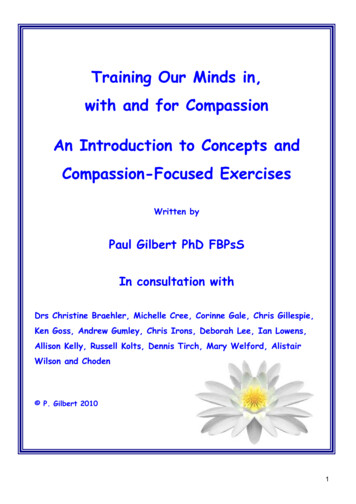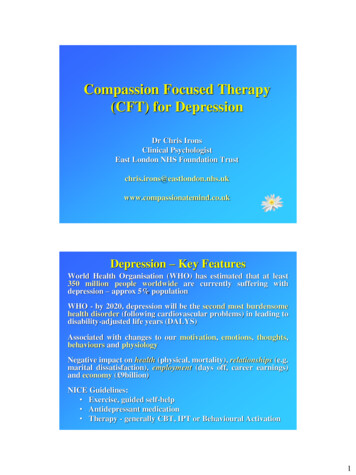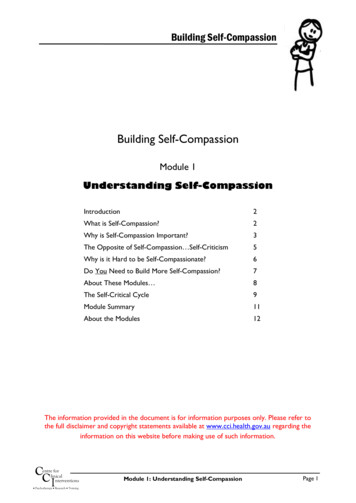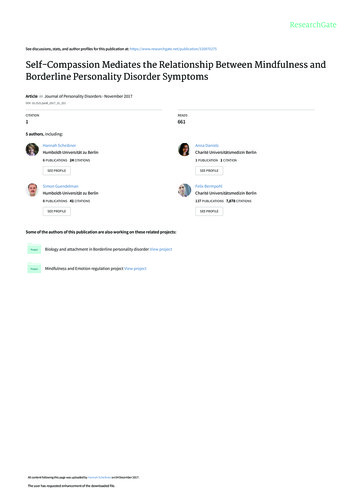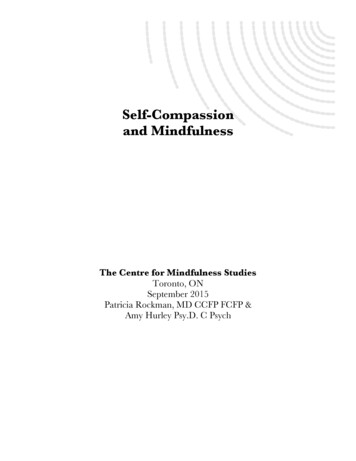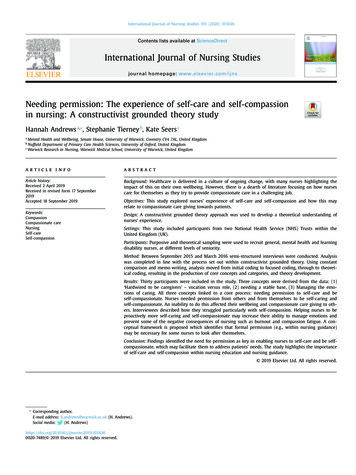
Transcription
International Journal of Nursing Studies 101 (2020) 103436Contents lists available at ScienceDirectInternational Journal of Nursing Studiesjournal homepage: www.elsevier.com/ijnsNeeding permission: The experience of self-care and self-compassionin nursing: A constructivist grounded theory studyHannah Andrews a, , Stephanie Tierney b, Kate Seers caMental Health and Wellbeing, Senate House, University of Warwick, Coventry CV4 7AL, United KingdomNuffield Department of Primary Care Health Sciences, University of Oxford, United KingdomcWarwick Research in Nursing, Warwick Medical School, University of Warwick, United Kingdombarticle infoabstractArticle history:Received 2 April 2019Received in revised form 17 September2019Accepted 18 September 2019Background: Healthcare is delivered in a culture of ongoing change, with many nurses highlighting theimpact of this on their own wellbeing. However, there is a dearth of literature focusing on how nursescare for themselves as they try to provide compassionate care in a challenging job.Keywords:CompassionCompassionate careNursingSelf-careSelf-compassionObjectives: This study explored nurses’ experience of self-care and self-compassion and how this mayrelate to compassionate care giving towards patients.Design: A constructivist grounded theory approach was used to develop a theoretical understanding ofnurses’ experience.Settings: This study included participants from two National Health Service (NHS) Trusts within theUnited Kingdom (UK).Participants: Purposive and theoretical sampling were used to recruit general, mental health and learningdisability nurses, at different levels of seniority.Method: Between September 2015 and March 2016 semi-structured interviews were conducted. Analysiswas completed in line with the process set out within constructivist grounded theory. Using constantcomparison and memo writing, analysis moved from initial coding to focused coding, through to theoretical coding, resulting in the production of core concepts and categories, and theory development.Results: Thirty participants were included in the study. Three concepts were derived from the data: (1)‘Hardwired to be caregivers’ – vocation versus role, (2) needing a stable base, (3) Managing the emotions of caring. All three concepts linked to a core process: needing permission to self-care and beself-compassionate. Nurses needed permission from others and from themselves to be self-caring andself-compassionate. An inability to do this affected their wellbeing and compassionate care giving to others. Interviewees described how they struggled particularly with self-compassion. Helping nurses to beproactively more self-caring and self-compassionate may increase their ability to manage emotions andprevent some of the negative consequences of nursing such as burnout and compassion fatigue. A conceptual framework is proposed which identifies that formal permission (e.g., within nursing guidance)may be necessary for some nurses to look after themselves.Conclusion: Findings identified the need for permission as key in enabling nurses to self-care and be selfcompassionate, which may facilitate them to address patients’ needs. The study highlights the importanceof self-care and self-compassion within nursing education and nursing guidance. 2019 Elsevier Ltd. All rights reserved. Corresponding author.E-mail address: h.andrews@warwick.ac.uk (H. Andrews).(H. Andrews)Social 360020-7489/ 2019 Elsevier Ltd. All rights reserved.
2H. Andrews, S. Tierney and K. Seers / International Journal of Nursing Studies 101 (2020) 103436What is already known about the topic? There has been a focus on compassionate care giving, but littleis known about how nurses care for themselves. The ability to apply self-care and self-compassion may reducelevels of compassion fatigue, burnout and vicarious traumatisation and foster resilience. Self-compassion is positively associated with wellbeing and lifesatisfaction. It is unclear how nurses perceive and experience their own selfcare and self-compassion in a role that can be both physicallyand emotionally demanding.What this paper adds Nurses require permission to be self-caring and selfcompassionate and can take the form of giving permissionto the self through the process of taking ownership and responsibility for his or her own wellbeing, or receiving moreformal permission from another. Many factors can facilitate or impede such permission, including identity, early experience, feeling safe, living with uncertainty and managing the emotions of caring. Nursing guidance, policies, reports, the media and nursing colleagues instilled the notion that patients take priority. Whilstthis was important for the role of a nurse, it was often interpreted in isolation, without consideration of the nurse’s ownneeds, which were pushed aside in favour of others. Participants held a good understanding of self-care and thefacets it encompassed and what it entailed for them. However,the tendency was to use self-care as a reactive coping strategy rather than as a proactive, preventative measure. If nursesare able to manage the emotions of caring by being self-awareand recognising when they need to apply self-care and selfcompassion, then they may feel more able to offer compassionate care to others.1. IntroductionThe focus of this paper centres around three terms: selfcare, self-compassion and compassionate care. Self-care is defined within existing literature as the process of taking steps toand engagement in activities to establish and maintain health(World Health Organisation, 1983; Department of Health, 2005;Lee and Miller, 2013; Webber et al., 2013). Literature defines selfcompassion as the ability to turn compassion inwards, to be kindto the self, and to acknowledge our humanity, imperfection andfragility (Heffernan et al., 2010; Neff, 2003; Lindstrom, 2014).Whilst these two terms are inward facing, compassionate care isoutward facing (with patients as a focus). It is defined within current literature as a collaboration and relational process of care,achieved by entering into the patient journey in order to relievesuffering (Fox, 1990; Nussbaum, 1996; Von Dietz and Orb, 20 0 0;Frank, 2004; Cozens and Cornwell, 2009; Dewar et al., 2014).Nurses tend to be closely associated with compassion in healthcare (Bivins et al., 2017). They spend large amounts of time withpatients and are involved in basic and complex (sometimes intimate) care processes. In practice, they deal with multiple stressors simultaneously, in increasingly complex environments (Crary,2013). Literature spanning a range of countries suggest that nursesappear to be under pressure to deliver care and meet targets inorganisations undergoing substantial change, resulting in increasing levels of stress, burnout and attrition from the profession(Lavoie-Tremblay et al., 2008; Boyle, 2011; Rudman and Gustavsson, 2011; Li et al., 2014). It is unclear whether nurses can utiliseself-care and self-compassion when facing these pressures in orderto deal with their own internal processes and emotions or to copewith the environment in which they work.Compassion in healthcare has been an area of debate in recentyears on an international scale (Sinclair et al., 2017). At the sametime, self-compassion as a concept has been discussed through thework of people like Neff (2003) and Gilbert, 2010; Webber et al.,2013. Increasing compassion for oneself and others is thought todecrease stress, improve staff wellbeing and patient care (Lamotheet al., 2014), whilst also maintaining organisational commitment(Lilius et al., 2008).The term compassion and the concept of compassionatecare have been embedded within international nursing policy(American Nurses Association (ANA), 2011; Curtis, 2013; CanadianNurses association (CAN), 2008; DoH, 2009; DoH, 2012; Nursing &Midwifery Council (NMC), 2015; Sinclair et al., 2017). There hasbeen a rising focus on compassionate care giving but little abouthow health professionals care for themselves. In a role that exposes them to difficult situations, such as death, illness, deterioration, and ethical dilemmas, which can lead to distress andconflicted feelings (Davidhizar, 1993; McAllister and McKinnon,2009), it has been suggested that to provide compassionate care,nurses need to be self-compassionate (Mills et al., 2014). Literature on fostering resilience and preventing burnout amonghealthcare professionals exists (Durkin et al. Carson, 2016; Friborg,et al., 2003; Marsh, 1996; McAllister and McKinnon, 2009;Newman, 2003; Skovholt and Trotter-Mathison, 2011), which hasoverlaps with self-care and self-compassion. However, it does notfully explore these concepts and how they are experienced, although it highlights that nurses may be required to foster self-careabilities to remain resilient in their work (Delgado et al., 2017).An ability to be self-caring and self-compassionate may reduce levels of compassion fatigue, burnout and vicarious traumatisation, whilst improving staff retention and engagement, andjob satisfaction (Abaci and Arda, 2013; Dominguez-Gomez et al.,2009; Elwood et al., 2011; Maslach, 2003; Newall and MacNeil,2010; Sabin-Farrell and Turpin, 2003). Within the existing literature, self-compassion has been associated positively with wellbeing, life satisfaction, emotional intelligence and effective copingstrategies (Barnard and Curry, 2011; Durkin et al., 2016; Heffernanet al., 2010; Reyes, 2012; Senyuva et al., 2013; Zessin et al., 2015).However, it is not known how self-compassion and self-care areexperienced in everyday nursing practice, how they can be cultivated, and the barriers to their use by nurses. The literature proposes a link between self-care, self-compassion and compassionatecare giving (Dewar et al., 2014; Gustin and Wagner, 2013; Mills etal., 2014), but only a limited amount of research has explored selfcompassion and self-care in nursing (Blum, 2014; Mills et al., 2018)and how these elements influence the delivery of compassionatecare. A greater understanding of these areas will support nurses tocare for themselves whilst providing quality, compassionate carefor patients.To explore these ideas and to develop a model to inform nursing practice, a Grounded Theory study was conducted. This studystemmed from a perceived need by the authors, who have a background in nursing/and or compassion in healthcare, to look at selfcare and self-compassion as experienced by nurses and how theyrelate to, and may influence, the provision of compassionate carefor others. The final conceptual framework proposes that nursesrequire permission (internal and external) in order to self-care andoffer themselves compassion.2. The studyThis study explored nurses’ personal experiences of self-careand self-compassion in practice. It resulted in the production ofa conceptual framework for use within nursing education, nursing
H. Andrews, S. Tierney and K. Seers / International Journal of Nursing Studies 101 (2020) 103436Table 1Examples from topic guide. What do you understand by the term self-compassion? How able are you to care for yourself during times of stress? What happens regarding self-care within your workplace? Is there anything that facilitates self-care? What are your thoughts regarding providing compassion to your patients?guidance for safe and effective practice, nursing policy and nursingpractice.2.1. AimsThe study sought to explore:– What are nurses’ experiences of self-care and self-compassion?– How do these experiences relate to compassionate care giving?2.2. DesignA constructivist grounded theory approach was adopted, guidedby the work of Charmaz (2014). Charmaz (2014) proposes the notion of theory generation, with Grounded Theory methods beingused flexibly in order to recognise the role of the researcher andthe ways in which theories are developed within the context ofsocial and power relations. The interpretive nature of Charmaz’sapproach allows for the role of the nurse researcher, taking theirpersonal and professional experience into account, alongside theexisting knowledge informing the field of enquiry.2.3. Sample/participantsIt was anticipated that the findings would have wider relevanceif data were collected from more than one clinical setting andspanned a variety of nursing specialties (Williams, 2002). Therefore, two National Health Service (NHS) Trusts were used for recruitment.Initially, a recruitment poster was sent via email to the researchdepartments and nurse leaders situated in both NHS trusts. Whennurses expressed an interest, they were sent the participant information sheet and consent form. Fifty-three nurses expressed aninterest; 30 were recruited, consented and interviewed. The remaining 23 did not respond to further correspondence or foundit difficult to arrange a time to meet. Purposive sampling was employed in this initial stage of recruitment, to ensure participantswere chosen based on the qualities and variables they possessedand to find people who could shed light on the topic of interest through knowledge or experience (Bernard, 2002; Etikan et al.,2016). Theoretical sampling, as suggested by Charmaz (2014), wasused as the study progressed, with participants asked to identifysuitable colleagues who could enrich the emerging theory. For example, it became apparent from the data that it would be useful tosample nurse leaders and newly qualified nurses to expand someof the emerging categories and to follow-up leads within the data.Data collection ceased after 30 nurses were interviewed as datasaturation was reached.2.4. Data collectionData were collected via semi-structured interviews, which tookplace in a clinical setting (n 27), in a university office (n 2)or in a participant’s home (n 1). Data were collected betweenSeptember 2015 and March 2016. All interviews were conductedby the lead author, lasted an average of one hour, and were audiorecorded and transcribed verbatim. Table 1 provides examples ofthe questions asked during the interviews.3Additional topics were added to follow lines of enquiry as theresearch evolved. These included motivations for going into nursing, nursing identity, impact of leadership, professional persona,impact of caring for patients, responsibility and permission.2.5. Ethical considerationsApproval to conduct the study was sought from the Universityethics committee and from relevant NHS Research and Development departments.McCosker et al. (2001) highlight that consideration must betaken by the researcher if sensitive phenomenon is being researched. This was recognised within the participant informationsheet and participants advised that support be sought if needed.Distress was expressed during some interviews (n 5) as participants acknowledged that they were not able to care for themselves, remembered difficult experiences, felt they had been mistreated by their organisation or expressed sadness at changeswithin the NHS. These issues were dealt with in the room and afollow up email. Many of the participants, not just those who hadexperienced distress, reflected that they found the process of talking during the interview to be cathartic, adding it had caused themto think about how to care for themselves more in the future.2.6. Data analysisInitial coding allowed for familiarisation with the data. This entailed line-by-line coding to become aware of potential categoriesand processes (Charmaz, 2006), with initial codes being groundedin the data. Focused coding was then used to identify emergingcore categories, remaining grounded in the data to some extent,but involving some clustering of ideas. The last stage of coding,theoretical coding then enabled the saturation of the core categories identified during focused coding, with the use of constantcomparison allowing the analysis to become much more analytical and interpretive, in order to advance towards concepts andan emerging theory. Charmaz (2014) states that theoretical codesare used to theorize the data and focused codes help to tell a coherent, analytical story. Within this study theoretical coding clarified and sharpened the analysis, enabling the move from initialcoding through to the final core process and development of theconceptual framework. Memo writing was utilised throughout tohelp with this process, by focusing on any coding changes or modifications, any explanations, reflections, ideas for theoretical sampling or any links to the existing literature (Pidgeon and Henwood,1996). An example memo can be found in Box 1:Box 1. Memo – ‘Halcyon days of nursing’‘Halcyon days of nursing’ – 22.03.16Participant DQ2 spoke about the ‘halcyon days of nursing’,during the 1980’s, 1990’s and early 20 0 0’s. On further discussion the changing NHS and culture was blamed on the moveto a more business-like model.Many of the participants reflected the changing face ofthe NHS and nursing in general with many reasons for thechanges being cited, including the above. Other changes featured the change in nurse training, negative healthcare enquiries with lessons learnt, changing management structures,more experienced staff leaving ward-based environments, amore threat focused environment and the constant restructuring.This will require further exploration as to whether thereis any research looking at the changes in nursing or whetherit is a more narrative experience at present. It seems to be arecurring theme throughout the data.
4H. Andrews, S. Tierney and K. Seers / International Journal of Nursing Studies 101 (2020) 103436Table 2Example of how analysis moved from raw data to concepts (moving from surface level description and summarizing towardsinterpretation and a broader conceptual understanding).2.7. Study rigourA link has also been made around not being able tohave fun at work anymore (participant RGN12). Why did thischange? Have rules and guidance changed so much that stafffeel unable to experience or have fun anymore. Is this realityor perception?‘we gave ourselves permission to have fun and we don’t dothat anymore (no) and I don’t think we’re good at doing thatwith our teams as well’ (RGN12)Table 2 highlights how analysis moved from raw data to a moreconceptual understanding of what interviewees had discussed.Each transcript was stored within NVIVO, which supported dataanalysis. NVIVO was used following coding on paper in an attemptto manage the vast array of collected data. NVIVO provided an audit trail, adding rigour to the analysis process.Rigour was demonstrated by the application of four criteriafor trustworthiness proposed by Charmaz (2006, p182): Credibility; Resonance; Originality; and Usefulness. The use of GroundedTheory and following its guidelines enhanced the credibility of thecurrent research. Polit and Beck (2008) identify triangulation as away of improving credibility. Within this research, data were collected from a range of sources, from interviewees working in different nursing disciplines, over two NHS trusts. Triangulation wasalso achieved through the process of discussing the data as a team.Resonance was demonstrated using two approaches. Firstly,theoretical saturation was reached after interviewing 30 participants, whereby no new data or leads were arising and categorieswere sufficiently dense. Secondly, member checking was utilised.Sandelowski (1993) identifies the twofold purpose of memberchecking as gaining feedback from participants pertaining to theinterpretation of the data collected and allowing participants ac-
H. Andrews, S. Tierney and K. Seers / International Journal of Nursing Studies 101 (2020) 103436Table 3Participant characteristics.5good nurses. So I think we are already in a sense hardwired to be,to be givers (ok), rather than looking after ourselves more’ (RGN6)Participant disciplineand 217401130729Non-clinical roleSenior clinical roleNon-clinical roleClinical roleClinical role (trained outside of UK)Clinical roleClinical roleClinical roleClinical role (trained outside of UK)Senior clinical roleSenior clinical roleSenior clinical roleSenior clinical RoleSenior clinical RMN12RMN1331653128481528193116Community clinicalCommunity clinicalCommunity clinicalClinical roleSenior clinical roleSenior clinical roleCommunity clinicalCommunity clinicalCommunity clinicalCommunity clinicalSenior clinical roleSenior clinical roleSenior clinical roleRNMH7Community clinical roleDQ1DQ23331Senior clinical roleSenior clinical rolerolerolerolerolerolerolerolecess to their data. Birt et al. (2016) suggest that ‘within a constructivist epistemology, it can be used as a way of enabling participantsto reconstruct their narrative through deleting extracts they feel nolonger represent their experience, or that they feel presents themin a negative way’ (p1803). Throughout interviews, paraphrasingand summarising were employed to check the interviewer’s understanding of what the participant was saying. Each participantwas sent their transcript to review. All were happy with their transcripts, with no data being removed aside from a couple of words,which they felt could impact anonymity.3. FindingsTable 3 provides an overview of the characteristics of nursesrecruited based on their discipline, years of experience and role;6 were male and 24 females. The blue lines split the groups intothose who were Registered General Nurses (RGN), Registered Mental Health Nurses (RMN), Registered Learning Disability Nurses(RNMH) and those who were Dual Qualified (DQ).3.1. The conceptsThe core concept to emerge from the data analysis was “Needing Permission” to be self-compassionate and self-caring. This coreconcept (which is described in more detail below) was informedby three concepts: Hardwired to be caregivers; Needing a stablebase; and Managing the emotions of caring.3.1.1. ‘Hardwired to be caregivers’ – vocation versus roleThe notion of ‘Hardwired’ refers to the innate need to nurse,motivations to enter nursing and how they fit with identity.‘you’ve attracted people who are of that mind set, you want tocare for others, you are essentially carers, otherwise you wouldn’tdo the job. The nurses that aren’t that way inclined tend not to beThe journey to being a nurse appeared to be an important concept when looking at permission to apply and accept self-care andself-compassion. Nursing identity incorporated ideas of character,sense of self and compassion as an inbuilt trait.‘you’ve got to be erm you know a certain character, a certain personality erm it’s such a rewarding job but it’s a hard job, it’s hardwork you know, harder than it’s ever been’ (RGN14)‘my view is that you’re born a compassionate individual or you’renot but there are some situations that people are put in that reduce that level of compassion, their ability to display it’ (RGN12)For each nurse this is likely to be different, shaped by early influences, experiences and role models. Hence, individuals will havevarying ideas about ‘being a nurse’. Some viewed it as a vocation and others more as a profession or a role. There appearedto be a link between the notion of nursing as a vocation, whichbrings with it an element of self-sacrifice, making self-care andself-compassion more difficult.‘a lot of people say, ‘oh nursing is what I do’, but a nurse is who Iam and when I’m not at work I feel a bit lost’ (RGN11)‘I think that sometimes people think that because you’re a nurseand that’s what you do for your job that you’re always your joband you’re always a nurse’ (RMN7)A contrasting viewpoint appeared to be that if nursing is regarded as a profession, a job or role, then self-compassion andself-care could be more accessible and acceptable. However, datasuggested a lack of clear distinction between nursing as a role oridentity, with nurses often changing their viewpoints as their careers and experience progressed, or if events occurred that causedthem to question their loyalty to the profession or organisation.3.1.2. Needing a stable baseData suggested that nurses need to feel safe and securein themselves and their workplace to be self-caring and selfcompassionate.‘you have to feel contained don’t you as an individual and as ateam and everything else, because of, you know if one, if you startto not feel that, then it starts to spread out to everything elsedoesn’t it’ (RMN3)A number of factors can get in the way of a stable base, such asthe working environment, jobs being at risk and having effective,clearly defined leadership.‘brilliant practitioners that were competent people would be coming in, in tears hiding in our recovery rooms and sort of saying ‘ohgod I’ve got to go back’ I don’t think they’re necessarily better orany worse than any other trust but I think they just do not valuethe resource they have and that’s pretty apparent because we can’tretain people’ (RMN12)‘the best wards I’ve worked on is where you have really good nursemanagers who recognise that terrible things happen and thatsometimes staff need time out to actually process that’ (RGN6)The effects of increased pressure in the workplace, a businessorientated approach to healthcare delivery and a broken systemappeared to have a de-stabilising effect; nurses could end up feeling like ‘automatons’ rather than professional carers, with technicalskills more highly valued compared to relational ones.‘Mental Health nursing used to be about a dynamic process responding to the environment through visibility, engagement, pres-
6H. Andrews, S. Tierney and K. Seers / International Journal of Nursing Studies 101 (2020) 103436ence and now like I say automaton is that the priority is thatyou’ve got to well I don’t know you’ve got to do your paperwork’(DQ2)Data analysis showed how the changing NHS and public perceptions could interfere with a nurse’s ability to feel safe and secure.‘If I said to people when I first started I’m a nurse I would havebeen perceived as an angel, you’re absolutely wonderful, I don’tknow how we could manage without you public perception haschanged very much so we’re perhaps not seen as these, you knowthese wonderful beings as we once were, we’re seen as maybe human beings that are fallible’ (DQ1)3.1.3. Managing the emotions of caringParticipants wanted and needed to care for others to feel valued. It was proposed that patients come first, a notion instilledthrough nursing guidance and expectations of their workplace,which was also an internal driver. However, whether this shouldbe to the detriment of oneself was questioned.‘I always would put my patients first but actually if I’ve got noself-compassion for myself and I’m not looking after myself I can’tgive my patients a hundred per cent so it works both ways really’(RGN14)‘I think people can probably provide compassionate care, the problem is their own wellbeing may suffer because, because they’re notable to be self-compassionate or self-caring so that their compassion may be almost too great if you like in terms of looking afterpeople and not looking after themselves’ (RGN4)Participants acknowledged that nursing could be difficult, requiring them to develop coping strategies in order to manage.This included ‘turning a page’ and becoming hardened through repeated exposure or closing off.‘so you’ve got all these things going on and real horrible thingserm you know real significant self-harm and traumas that childrengo through and you’re just like ‘ok right what’s happened now,oh someone’s been raped, oh what’s happened now oh there’s asuicide and you’re like ok next thing lets go see’ and sometimes wejust get a bit hardened to that (mmm) and then when it catchesall up on you and you think oh no this is awful, this has happenedin one day, it’s not very nice’ (RMN8)Interviewees proposed that nurses are sometimes viewed as aresource rather than as human beings who can become exhaustedwhen overwhelmed or placed under pressure, with burnout occurring when there is an inability to cope.‘you know it’s tragic, you do walk on wards and find nurses whoburst into tears when you ask them about things and it happensand they’re getting themselves so stressed out and we don’t, wedon’t teach them to look after themselves, we don’t teach themhow to recognise when things are going wrong for themselves. Weteach them to recognise it in the patients (mmm) but not in themselves or in their colleagues’ (RGN2)If participants were overwhelmed, burnt out or unable to applyself-care or self-compassion, there was a risk of ‘thinner care’.‘it certainly makes the care that they give thinner or so it canseem, coz they’re spreading themselves so thin and I think it’s valuable that we look after ourselves’ (RNMH)Findings suggest that to manage the emotions of caring, an element of permission to be self-caring and self-compassionate wasrequired. However, balancing compassion towards the self and others was called for, as was an awareness of whether self-care andself-compassion were being used proactively in order to cope withnegative effects of nursing, or reactively (when self-care and selfcompassion were only accessed when nurses were already struggling).3.1.4. Core concept: needing permissionAs mentioned above, interviewees described how permissionfor self-compassion was needed from themselves and from others.Permission may be given to the self by looking at the need to takeownership for one’s own wellbeing. A barrier to doing this was related, by interviewees, to how self-compassion was perceived; itcould be viewed as a weakness and, therefore, potentially problematic.‘I think as a profession in general we are very very bad at givingourselves permission to look after ourselves I was gonna say inthe past but even now it is seen as a weakness, which is very sad you are expected to push yourself to do things and I think it isabout giving people permission to, just to look
2 H. Andrews, S. Tierney and K. Seers / International Journal of Nursing Studies 101 (2020) 103436 What is already known about the topic? There has been a focus on compassionate care giving,
